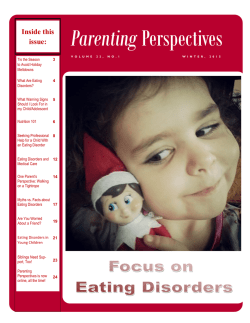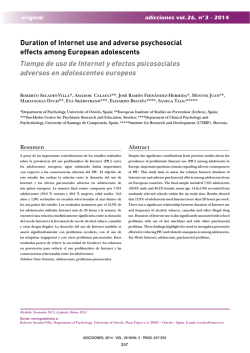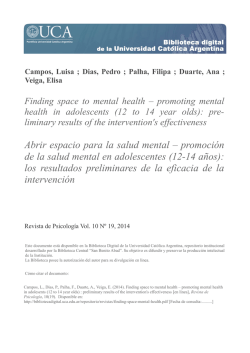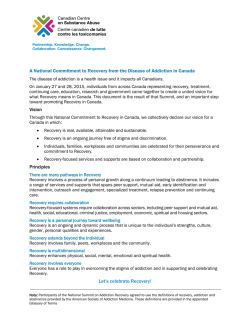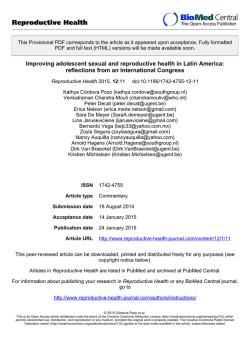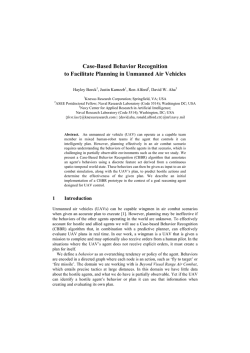
Risky eating behaviors and beliefs among adolescent girls
500683 13 HPQ0010.1177/1359105313500683Journal of Health PsychologyCruz-Sáez et al. Article Risky eating behaviors and beliefs among adolescent girls Journal of Health Psychology 2015, Vol. 20(2) 154–163 © The Author(s) 2013 Reprints and permissions: sagepub.co.uk/journalsPermissions.nav DOI: 10.1177/1359105313500683 hpq.sagepub.com Soledad Cruz-Sáez, Aitziber Pascual, Karmele Salaberria, Itziar Etxebarria and Enrique Echeburúa Abstract This study investigated the prevalence of weight control and binge eating behaviors in a sample of 767 adolescent girls aged 16–20 years, and the differences between adolescents with and without altered eating behaviors regarding anthropometric and body image variables and beliefs associated with eating disorders. Adolescents who engaged in unhealthy strategies were found to be at a higher risk of eating disorders, since these behaviors were accompanied by higher levels of drive for thinness and body dissatisfaction, as well as by beliefs associated with the importance of weight and body shape as a means of personal and social acceptance. Keywords adolescence, beliefs, binge eating, diet, eating disorders Introduction Many adolescents, particularly girls, are involved in unhealthy eating and weight control behaviors (restricted intake, laxatives, diuretics or diet pills, and induced vomiting) due to social emphasis on appearance, image, and physical attractiveness (Thøgersen-Ntoumani et al., 2010). The high prevalence of these behaviors may constitute a serious health problem, due to their adverse effects on the physical, emotional, and psychosocial health of young people (Maor et al., 2006; Neumark-Sztainer et al., 2002). According to various studies, this type of behavior may lead to nutritional deficiencies, eating disorders (EDs), obesity, depression, and suicide attempts (Neumark-Sztainer et al., 2004; Stice et al., 1999). Over recent years, many studies on EDs have focused on assessing the nature and correlates of EDs. One of the factors that appears time and time again in studies with adolescents suffering from EDs is a high level of dissatisfaction with their body image because of the internalization of the thin ideal. Indeed, body dissatisfaction, the drive for thinness, and a distorted perception of one’s weight are factors University of the Basque Country (UPV/EHU), Spain Corresponding author: Soledad Cruz-Sáez, University of the Basque Country, (UPV/EHU), Avenida de Tolosa, 70, San Sebastián, 20018, Spain. Email: [email protected] Downloaded from hpq.sagepub.com by Soledad Cruz on January 30, 2015 155 Cruz-Sáez et al. associated with extreme weight control strategies in adolescents (Vander Wall, 2011). The internalization of the thin ideal is mediated by characteristics such as body weight, general self-determination, self-esteem, and the filtering of media messages through cognitive strategies (Ahern et al., 2011; Bojorquez et al., 2013; Mask and Blanchard, 2011; Shroff and Thompson, 2006) Cognitive theories on EDs highlight the importance of underlying beliefs regarding weight, body shape, and eating as causal factors in the development and maintenance of an altered eating behavior (Cooper et al., 2004). There are two types of relevant cognitions: those that are specific to the disorder, which refer to eating, body shape, and weight (Cooper et al., 2004; Mizes et al., 2000), and personal ones, which are generalized beliefs regarding oneself. Consequently, both negative selfbeliefs and underlying attitudes to weight, body shape, and eating must be present in order for an ED to develop and be maintained (Cooper, 2005). The majority of research carried out with adolescents has focused on the risk behaviors or factors related to EDs. Hardly any studies, however, have integrated these behaviors into an analysis of cognitions. Nevertheless, the joint use of measures focusing on specific cognitions and personal beliefs may enable a better discrimination between adolescents with and without EDs. It may also permit the subclinical symptoms of EDs to be distinguished from symptoms of depression in the adolescent population (Cooper et al., 2005, 2006; Muris, 2006; Pascual et al., 2011). This study, therefore, has the following aims: (a) to study the prevalence of altered eating behaviors (binge eating and unhealthy weight control behaviors) among adolescent girls, (b) to analyze the differences between adolescents with and without altered eating behaviors in relation to anthropometric variables, body dissatisfaction, and beliefs associated with EDs, and (c) to study the differences between adolescents in the aforementioned variables in accordance with whether they suffer from a single altered behavior (diet and binge eating) or a combination of altered behaviors (diet and binge eating, diet and other method, etc.). Method Participants Participants were 767 girls aged between 16 and 20 years from 13 secondary schools and 5 universities in the Basque Country (Spain). The mean age was 17.54 (standard deviation (SD) = 1.26). Of the total group, 43 percent were in the junior year of high school, 19 percent were in the senior year of high school, 24 percent were in the first year of their undergraduate degree, and 14 percent in the second year of their undergraduate degree. The assessment was carried out during 2007 and 2008. The mean body mass index (BMI) of participants was 22.35 (SD = 3.06). Measures Anomalous eating behaviors Weight control behaviors. To assess this aspect, we used an adaptation of the NeumarkSztainer et al. (2002) questions. Participants were asked if they had engaged in any of the following behaviors in order to lose weight or change their body shape during the last year: “dieting,” “induced vomiting,” “taking laxatives,” “taking diuretics,” or “taking diet pills.” Respondents were asked to provide a yes or no answer to each of the behaviors. In relation to the aforementioned behaviors, they were also asked to indicate whether “they had repeated them 2 or more times a week for 3 consecutive months over the last 12 months.” In relation to physical activity, respondents were asked “Over the last 4 weeks, have you engaged in any physical exercise as a means of controlling your weight, changing your body shape or reducing body fat?” Response options were “no,” “yes, less than 4 hours a week,” “yes, between and Downloaded from hpq.sagepub.com by Soledad Cruz on January 30, 2015 156 Journal of Health Psychology 20(2) 4 and 7 hours a week,” and “yes, more than 7 hours a week” (excessive exercise). Binge eating. To assess binge eating, participants were asked “Over the last 12 months (not including special celebrations), have you binged? In other words, have you eaten a lot of food in a short space of time (e.g. 1 or 2 hours) with the feeling that you have lost control and that you cannot stop eating?” (yes/no) and “Over the last 12 months, have you indulged in this type of binge eating at least twice a week for 3 consecutive months?” (yes/no). Body image dissatisfaction Eating Disorder Inventory. Eating Disorder Inventory (EDI-2) assesses behaviors and symptoms associated with EDs (Garner, 1991/adapted by TEA, 1998). It is a self-report instrument with 91 elements. Responses are given on a 6-point Likert-type scale (from “never” to “always”), providing scores on 11 scales. In this study, only the first 3 subscales were used, since they assess attitudes and behaviors related to eating, weight, and body image: drive for thinness, bulimia, and body dissatisfaction. The instrument has adequate psychometric qualities. The reliability data indicate an internal consistency (Cronbach’s α) of over .80 in sample groups of patients with EDs, and coefficients between .65 and .92 in nonclinical samples (Garner and Olmstead, 1984; Shore and Porter, 1990). In Spanish samples, the internal consistency of the elements has been analyzed (TEA, 1998) applying the split-half method, with the results being similar to those obtained in the American sample, particularly with regard to the clinical group (r = .76 to r = .91). Beliefs associated with EDs Eating Disorder Belief Questionnaire. Eating Disorder Belief Questionnaire (EDBQ) is a self-report instrument consisting of 32 items designed to assess core attitudes and beliefs associated with EDs. Items are assessed on a scale from 0 (I do not usually believe this at all) to 100 (I am usually completely convinced that this is true) (Cooper et al., 1997). The questionnaire is made up of four subscales: (a) importance of weight and body shape as a means of self-acceptance, (b) importance of weight and body shape as a means of being accepted by others, (c) negative self-beliefs, and (d) control over eating. In the initial validation study (Cooper et al., 1997), both the reliability (the Cronbach’s α for each factor oscillated between .86 and .94) and the validity of the construct (the correlations between the 4 subscales and other ED measures were all highly significant, p < .01) were found to be good. In this study, the Cronbach’s α for the total scale was .95, and for the subscales, it ranged from .81 to .90. Procedure This research dealt with a cross-sectional study with a nonprobabilistic sample. This study was approved by the Ethics Committee of the University of the Basque Country. After educational centers agreed to participate in the investigation, a letter providing information related to the research was sent to the students’ parents. Participants were given the questionnaires with the tasks to be performed, along with instructions for completing them. They were then given approximately half an hour to complete the scales and questionnaires described above and, in the case of those who were of age, to sign an informed consent form. In those cases in which participants were minors, the informed consent of their families was requested. In all cases, participants were reminded that the information provided was anonymous and confidential. The instruments were applied by two qualified psychologists in the classrooms of the school or university that the students attended. Once the questionnaires had been completed, one of the psychologists measured the weight and height of each participant, in order to obtain their BMI. To encourage them to take part in the study, the psychologists offered to send them the results. Downloaded from hpq.sagepub.com by Soledad Cruz on January 30, 2015 157 Cruz-Sáez et al. Statistical analyses Differences between adolescents with and without anomalous The statistical analyses were carried out with eating behaviors in relation the SPSS program (version 19.0 for Windows). to anthropometric variables, Descriptive statistics (means, SD, and percentdissatisfaction with body image, ages) were obtained for the demographic variaand beliefs (Table 1) bles and psychometric scales. To analyze the differences between those adolescents who had engaged in some kind of weight control behavior and those who had not, Student’s t was calculated as a contrast test, and Cohen’s d was calculated to estimate the effect size of the difference. When more than two groups were compared, an analysis of variance was conducted using the Kruskal–Wallis H test, due to the differences in the sample size and the heterogeneity of the variances. For the post hoc tests between group pairings, we obtained the Mann–Whitney U and calculated the r to check the effect size. Results Anomalous eating behaviors Of the 767 adolescents who made up the total sample group, 262 (34%) reported having engaged in one or more anomalous eating behaviors over the last year. The most frequent behaviors were dieting (25%) and binge eating (23%), and the least frequent were taking diet pills (4%) and laxatives (2%). Of the total participants, 6 percent reported having induced vomiting, and the percentage of those who admitted to get involved in excessive exercise and to take diuretics was in both cases 4 percent. A total of 87 adolescents (11%) reported having engaged in some kind of weight control behavior and/or binge eating two or more times a week for three consecutive months. In specific terms, 33 percent of those adolescents who had binged, 53 and 32 percent of those who had taken diuretics and diet pills, respectively, 28 percent of those who had taken laxatives, and 43 percent of those who had induced vomiting had engaged in these behaviors with the aforementioned frequency. With regard to anthropometric variables, moderately large and statistically significant differences were observed in weight (p = .000, d = .41) and BMI (p = .000, d = .47), although not in height. Adolescents with altered eating behaviors weighed more and had a higher BMI. In relation to body image dissatisfaction, adolescents who engaged in anomalous behaviors scored notably higher in the drive for thinness (p = .000, d = .87) and body dissatisfaction (p = .000, d = .79) scales, and somewhat higher in the bulimia scale (p = .000, d = .64) of the EDI-2. Significant differences were also found between adolescents with and without anomalous eating behaviors in all the subscales of the belief questionnaire. The greatest differences between the two groups were observed in the subscale related to the importance of weight and body shape as a means of self-acceptance (p = .000, d = .83). In the control over eating (p = .000, d = .68), importance of weight and body shape as a means of being accepted by others (p = .000, d = .55), and negative self-beliefs (p = .000, d = .43) subscales, the differences observed were moderate. Differences in anthropometric variables, dissatisfaction with body image, and beliefs in adolescents with anomalous eating behaviors The 262 adolescents who reported some kind of anomalous eating behavior were divided into those whose only weight control method had been dieting (n = 79, 30%), those who had engaged in binge eating (n = 93, 35%), those who had combined dieting and binge eating (n = 33, 13%), and those who had combined dieting with another weight control method (excessive Downloaded from hpq.sagepub.com by Soledad Cruz on January 30, 2015 158 Journal of Health Psychology 20(2) Table 1. Differences between adolescents with and without anomalous eating behaviors in relation to anthropometric variables, dissatisfaction with body image, and beliefs associated with eating disorders. Variables Without anomalous eating behaviors (n = 505) M Anthropometric variables Height Weight BMI EDI-2 scales Drive for thinness Bulimia Body dissatisfaction EDBQ scales IWBS-SA IWBS-AO Negative self-beliefs Control over eating SD With anomalous eating behaviors (n = 262) M SD t (gl) 1.64 58.36 21.72 0.06 8.41 2.71 1.64 62.04 23.12 0.06 9.58 3.2 t(732) = 0.26 t(732) = −5.42*** t(732) = −6.28*** 2.32 0.91 6.21 3.34 1.63 5.42 6.52 2.67 11.1 5.96 3.5 6.82 t(730) = −11.17*** t(722) = −8.27*** t(724) = −10.33*** 27.84 9.81 13.51 10.55 20.81 13.27 14.19 12.41 47.59 19.2 20.46 22.68 26.32 20.42 17.94 21.8 t(722) = −10.87*** t(724) = −7.04*** t(723) = −5.62*** t(726) = −8.78*** SD: standard deviation; BMI: body mass index; EDI: Eating Disorder Inventory; EDBQ: Eating Disorder Belief Questionnaire; IWBS-SA: importance of weight and body shape for self-acceptance; IWBS-AO: importance of weight and body shape for acceptance by others. ***p < .001. exercise, diuretics, diet pills, laxatives, or vomiting) (n = 31, 12%). The remaining 26 adolescents (10%) had attempted to control their weight using one or more methods, which did not include either dieting or binge eating. When the four groups were compared in relation to anthropometric variables, concern for body image, and beliefs, significant global differences, as shown in Table 2, were found among the groups in all variables, with the exception of height and the negative self-beliefs subscale. According to the analyses of the group pairings (2 × 2), adolescents who had only dieted had higher values than those who had only engaged in binge eating in weight (U = 2199, p = .000, r = .35), BMI (U = 1951.5, p = .000, r = .40), and drive for thinness (U = 2346.5, p = .000, r = .31), although these differences were of medium size. The bulimia scale was the only one on which adolescents who had engaged in binge eating scored significantly higher (U = 2010.5, p = .000, r = .40). No significant differences were found between the diet and binge eating groups with regard to body dissatisfaction or any of the subscales of the belief questionnaire. Adolescents who had engaged in both dieting and binge eating scored significantly higher than those who had only dieted on the bulimia (U = 535, p = .000, r = .49) and body dissatisfaction (U = 860.5, p = .007, r = .25) scales, as well as on the importance of weight and body shape for self-acceptance (U = 962, p = .036, r = .19) and control over eating (U = 788, p = .001, r = .30) subscales. Adolescents who had combined dieting with another weight control method scored significantly higher than those who only dieted on the drive for thinness scale (U = 888, p = .025, r = .21), the importance of weight and body shape for both self-acceptance (U = 843, p = .014, r = .23) and for acceptance by others (U = 811.5, p = .007, r = .26), and control over eating (U = 689.5, p = .000, r = .33) subscales. Downloaded from hpq.sagepub.com by Soledad Cruz on January 30, 2015 159 Cruz-Sáez et al. Table 2. Differences between the different weight control groups in relation to anthropometric variables, dissatisfaction with body image, and beliefs associated with eating disorders. Variables Dieting (n = 79) M Anthropometric variables Height 1.64 Weight 63.97 BMI 23.79 EDI-2 scales Drive for 5.98 thinness Bulimia 1.03 Body 10.1 dissatisfaction Belief questionnaire IWBS-SA 40.89 IWBS-AO 15.47 Negative self- 16.56 beliefs Control over 16.54 eating Binge eating (n = 93) SD M SD Dieting and binge eating (n = 33) M SD Dieting and another weight control method (n = 31) Kruskal–Wallis H (gl) M SD 0.06 8.49 2.5 1.64 57.88 21.63 0.06 7.4 2.37 1.64 62.33 23.10 0.06 8.65 3.14 1.64 68.14 25.30 0.06 12.65 4.46 H(3) = 0.62 H(3) = 31.88*** H(3) = 38.19*** 4.88 3.7 4.88 7.55 5.6 9.36 6.77 H(3) = 33.94*** 1.73 5.98 3.1 8.46 3.32 6.16 4.18 13.63 3.53 6.6 1.39 13.01 2.42 6.91 H(3) = 43.04*** H(3) = 20.74*** 21.23 18.74 14.28 40.43 14.20 17.16 25.47 15.77 14.1 51.46 23.99 24.07 25.76 23.08 18.28 54.30 26.39 22.61 27.29 24.36 22.25 H(3) = 10.39* H(3) = 10.27* H(3) = 4.59 18.23 15.98 17.72 26.82 18.23 33.5 23.93 H(3) = 24.56*** SD: standard deviation; BMI: body mass index; EDI: Eating Disorder Inventory; IWBS-SA: importance of weight and body shape for self-acceptance; IWBS-AO: importance of weight and body shape for acceptance by others. *p < .05; ***p < .001. Also, adolescents who engaged in both dieting and binge eating scored significantly higher than those who reported only binge eating in weight (U = 1101.5, p = .016, r = .21), BMI (U = 1159, p = .037, r = .19), drive for thinness (U = 832.5, p = .000, r = .35), and body dissatisfaction (U = 863.5, p = .000, r = .33), as well as in importance of weight and body shape for self-acceptance (U = 1137, p = .039, r = .18) and control over eating (U = 907, p = .001, r = .31). Similarly, adolescents who had combined dieting with another weight control method had higher values than those who only engaged in binge eating for weight (U = 646, p = .000, r = .41) and BMI (U = 627.5, p = .000, r =.42) and scored higher in drive for thinness (U = 647, p = .000, r = .41) and body dissatisfaction (U = 881.5, p = .001, r = .29), as well as in importance of weight and body shape for selfacceptance (U = 843, p = .014, r = .22) and acceptance by others (U = 940.5, p = .005, r = .26) and control over eating (U = 790.5, p = .000, r = .33). Only in the bulimia scale did adolescents report binge eating score significantly higher than those who combined dieting with another weight control method (U = 889, p = .001, r = .29). Finally, the dieting and binge eating group differed significantly from the dieting and other weight control method group in that they were found to weigh less (U = 350, p = .03, r = .27) and have a lower BMI (U = 335, p = .18, r = .30) and scored higher in bulimia (U = 243, p = .000, r = .46). Discussion Of the total sample group of 767 adolescent girls aged between 16 and 20 years, 34 percent reported having engaged in anomalous eating Downloaded from hpq.sagepub.com by Soledad Cruz on January 30, 2015 160 Journal of Health Psychology 20(2) behaviors during the last year. In specific terms, it is likely that 11 percent of the adolescents in the sample group had some kind of ED, since they reported extreme forms of weight control behavior or binge eating (i.e. at least twice a week for three consecutive months). Similar data have been obtained in other studies on the prevalence of weight control methods among adolescents and youths (Lameiras et al., 2003; Sepúlveda et al., 2010). The most frequent altered behaviors were dieting (25%) and binge eating (23%), with the other types of weight control behaviors being found in 6 percent or less of the sample group. The frequencies of weight control strategies observed here were similar to those found by Góngora and Casullo (2008) and ThøgersenNtoumani et al. (2010). According to NeumarkSztainer et al. (2006), there is an association between dieting and subsequent binge eating, as well as extreme weight control behaviors and EDs, which suggests that going on a diet may constitute the first step towards developing a severe ED. As in other studies (Neumark-Sztainer et al., 2012; Vander Wall, 2011), the adolescents in our sample group who reported anomalous eating behaviors (34%) also had higher weight and BMI values than those who did not, although it should be pointed out that they were not overweight as such, since their mean BMI was 23.12 (SD = 3.2). They were, however, a group with notably higher levels of drive for thinness and body dissatisfaction, as well as, to a lesser extent, bulimia. These adolescents also differed from those who did not report anomalous eating behaviors in relation to their beliefs about eating; especially large differences were found in relation to the importance attached to weight and body shape for self-acceptance. Differences were also found, although in this case they were moderate in nature, in control over eating, the importance of weight and body shape for acceptance by others, and negative self-beliefs. These data suggest that adolescents who employ weight control methods and engage in binge eating have beliefs about eating that are similar to those who are at risk of or suffering from EDs. Future studies should analyze whether adolescents with harmful weight control behaviors, such as those found by Mask and Blanchard (2011), have also internalized the thin ideal more as the result of low self-determination. These results coincide with those found by other authors in relation to dieting (Cooper and Turner, 2000; O’Connor et al., 2003), and the presence of these beliefs may also be extended to adolescents who use weight control methods other than dieting (Góngora and Casullo, 2008). Moreover, the data indicate the need to conduct psychoeducational programs that include information about unhealthy weight control behaviors and their negative effects on the physical and psychological health of adolescents (Kalavana et al., 2010; Sepúlveda et al., 2007). At the same time, interventions should be directed at self-regulation cognitions as well as at family and peer influence (González et al., 2012; Shroff and Thompson, 2006; Unikel et al., 2012) and other relational aspects of their lives (Bojorquez et al., 2013). With regard to the differences observed in accordance with the type and number of anomalous eating behaviors, differences were found between adolescents who dieted as the only form of weight control, those who had binge eating, those who combined dieting with binge eating, and those who combined dieting with another weight control method (laxatives, diet pills or diuretics, or induced vomiting). These differences were found in relation to the anthropometric variables of weight and BMI, the three subscales of the EDI-2 (drive for thinness, bulimia, and body dissatisfaction), and three subscales of the EDBQ (importance of weight and body shape for self-acceptance and acceptance by others and control over eating). In the EDBQ-negative self-beliefs subscale, the differences found were not significant. In the anthropometric variables of weight and BMI, adolescents who reported having dieted, either as the only method or in combination with binge eating or another weight control method, had significantly higher values than Downloaded from hpq.sagepub.com by Soledad Cruz on January 30, 2015 161 Cruz-Sáez et al. those who only reported binge eating. These data suggest that BMI (real or perceived) may be a precipitating factor for weight control through restricted intake (i.e. dieting). Moreover, as Neumark-Sztainer et al. (2012) point out, persistent dieting and weight control methods lead, paradoxically, to a subsequent and notable increase in BMI, both in normal weight and overweight adolescents, particularly when the strategies used include skipping meals, eating very little, or taking diet pills. The results indicate that adolescents who combined dieting with another type of altered behavior (binge eating, excessive exercise, taking laxatives or diuretics, or induced vomiting) were at greater risk of EDs. In previous studies, excessive concern about and dissatisfaction with one’s body image has been found to be one of the principal factors for risk and maintenance of EDs (Neumark-Sztainer et al., 2006; Vander Wall, 2011). With regard to beliefs associated with EDs, adolescents who combined dieting and binge eating, or dieting and another weight control method (and particularly this latter group), attached the most importance to weight and body shape as a means for self-acceptance and acceptance by others; they also held more beliefs regarding the need for greater control over eating and were therefore the group most at risk. The results of the study confirm that adolescents are vulnerable to the risk of developing unhealthy eating behaviors, particularly when they hold negative beliefs about both eating and themselves. Nevertheless, the mechanism by which these behaviors facilitate the development of EDs in some adolescents but not others is as yet unclear and requires further research. The study’s main contribution is that it was conducted with a broad sample of adolescent girls and focuses on detecting the most common forms of weight control that generally go unnoticed and pose a serious risk to teenage health. Moreover, the findings may help enable the early identification of adolescents with altered eating or weight control patterns, allowing the risk of EDs to be averted in this population. One of the limitations of this work is that, since it is a cross-sectional study, it is not possible to establish causal relations between variables. Another limitation is that the data were gathered in a single phase, through self-reports. One challenge for the future is to include the assessment of other personality or psychopathology variables, which may help us gain a better understanding of the results, and to carry out long-term follow-up studies. Funding This was supported by the Basque Governments Consolidated Clinical Psychology Research Group and the University of the Basque Country (UPV/ EHU) UFI 11/04. References Ahern AL, Bennett KM, Kelly M, et al. (2011) A qualitative exploration of young women’s attitudes towards the thin ideal. Journal of Health Psychology 16(1): 70–79. Bojorquez I, Unikel C, Mendoza ME, et al. (2013) Another body project: The thin ideal, motherhood and body dissatisfaction among Mexican women. Journal of Health Psychology. DOI: 10.1177/1359105313484783. Cooper M and Turner H (2000) Underlying assumptions and core beliefs in anorexia nervosa and dieting. British Journal of Clinical Psychology 39(2): 215–218. Cooper M, Cohen-Tovée E, Todd G, et al. (1997) The eating disorder belief questionnaire: Preliminary development. Behaviour Research and Therapy 35(4): 381–388. Cooper MJ (2005) Cognitive theory in anorexia nervosa and bulimia nervosa: Progress, development and future directions. Clinical Psychology Review 25(4): 511–531. Cooper MJ, Wells A and Todd G (2004) A cognitive model of bulimia nervosa. British Journal of Clinical Psychology 43(1): 1–16. Cooper M, Rose KS and Turner H (2005) Core beliefs and the presence or absence of eating disorder symptoms and depressive symptoms in adolescent girls. International Journal of Eating Disorders 38(1): 60–64. Downloaded from hpq.sagepub.com by Soledad Cruz on January 30, 2015 162 Journal of Health Psychology 20(2) Cooper M, Rose KS and Turner H (2006) The specific content of core beliefs and schema in adolescent girls high and low in eating disorder symptoms. Eating Behaviors 7(1): 27–35. Garner DM (1991) Eating Disorder Inventory-2: Professional Manual. Odessa, FL: Psychological Assessment Resources (Spanish adaptation, TEA, 1998). Garner DM and Olmstead MP (1984) Manual for the Eating Disorder Inventory (E.D.I.). Odessa, FL: Psychological Assessment Resources. Góngora V and Casullo MM (2008) Conductas y cogniciones relacionadas con los trastornos de la conducta alimentaria en estudiantes universitarios. Revista Argentina de Clínica Psicológica XVII: 265–272. González ML, Mora M, Penelo E, et al. (2012) Qualitative findings in a long-term disordered eating prevention programme follow-up with school– going girls. Journal of Health Psychology 18(4): 587–598. Kalavana TV, Maes S and De Gucht V (2010) Interpersonal and self-regulation determinants of healthy and unhealthy eating behavior in adolescents. Journal of Health Psychology 15(1): 44–52. Lameiras M, Calado M, Rodríguez Y, et al. (2003) Hábitos alimentarios e imagen corporal en estudiantes universitarios sin trastornos alimentarios. Revista Internacional de Psicología Clínica y de la Salud [International Journal of Clinical and Health Psychology] 3(1): 23–33. Maor NR, Sayag S, Dahan R, et al. (2006) Eating attitudes among adolescents. Israel Medical Association Journal 8: 627–629. Mask L and Blanchard CM (2011) The protective role of general self-determination against “thin ideal” media exposure on women’s body image and eating–related concerns. Journal of Health Psychology 16(3): 489–499. Mizes JS, Christiano B, Madison J, et al. (2000) Development of Mizes anorectic cognitions questionnaire revised: Psychometric properties and factor structure in a large sample of eating disorder patients. International Journal of Eating Disorders 28(4): 415–421. Muris P (2006) Maladaptive schemas in non-clinical adolescents: Relations to perceived parental rearing behaviours, big five personality factors and psychopathological symptoms. Clinical Psychology and Psychotherapy 13(6): 405–413. Neumark-Sztainer D, Hannan PJ, Story M, et al. (2004) Weight–control behaviors among adolescent girls and boys: Implications for dietary intake. Journal of the American Dietetic Association 104(6): 913–920. Neumark-Sztainer D, Story M, Hannan PJ, et al. (2002) Weight–related concerns and behaviors among overweight and nonoverweight adolescents: Implications for preventing weight–related disorders. Archives of Pediatric and Adolescent Medicine 156(2): 171–178. Neumark-Sztainer D, Wall M, Guo J, et al. (2006) Obesity, disordered eating, and eating disorders in a longitudinal study of adolescents: How do dieters fare five years later? Journal of the American Dietetic Association 106(4): 559–568. Neumark-Sztainer D, Wall M, Guo J, et al. (2012) Dieting and unhealthy weight control behaviors during adolescence: Associations with ten-year changes in body mass index. Journal of Adolescent Health 50(1): 80–86. O’Connor M, Simmons T and Cooper M (2003) Assumptions and belief, dieting and predictors of eating disorder–related symptoms in young women and young men. Eating Behaviors 4(1): 1–6. Pascual A, Etxebarria I, Cruz MS, et al. (2011) Las variables emocionales como factores de riesgo de los trastornos de la conducta alimentaria. International Journal of Clinical and Health Psychology 11: 229–247. Sepúlveda AR, Carrobles JA and Gandarillas A (2010) Associated factors of unhealthy eating patterns among Spanish university students by gender. Spanish Journal of Psychology 13(1): 364–375. Sepúlveda AR, Carrobles JA, Gandarillas A, et al. (2007) Prevention program for disturbed eating and body dissatisfaction in a Spanish university population: A pilot study. Body Image 4(3): 317–328. Shore RA and Porter JE (1990) Normative and reliability data for 11 to 18 year olds on the eating disorder inventory. International Journal of Eating Disorders 9(2): 201–207. Shroff H and Thompson JK (2006) Peer influences, body–image dissatisfaction, eating dysfunction and self-esteem in adolescent girls. Journal of Health Psychology 11(4): 533–551. Stice E, Cameron R, Killen JD, et al. (1999) Naturalistic weight reduction efforts prospectively predict Downloaded from hpq.sagepub.com by Soledad Cruz on January 30, 2015 163 Cruz-Sáez et al. growth in relative weight and onset of obesity among female adolescents. Journal of Consulting and Clinical Psychology 67(6): 967–974. Thøgersen-Ntoumani C, Ntoumanis N and Nikitaras N (2010) Unhealthy weight control behaviours in adolescent girls: A process model based on self-determination theory. Psychology & Health 25(5): 535–550. Unikel C, Martín V, Juárez F, et al. (2012) Disordered eating behavior and body weight and shape relatives’ criticism in overweight and obese 15 to 19 year old females. Journal of Health Psychology 18(1): 75–85. Vander Wall JS (2011) Unhealthy weight control behaviors among adolescents. Journal of Health Psychology 17(5): 110–120. Downloaded from hpq.sagepub.com by Soledad Cruz on January 30, 2015
© Copyright 2026

